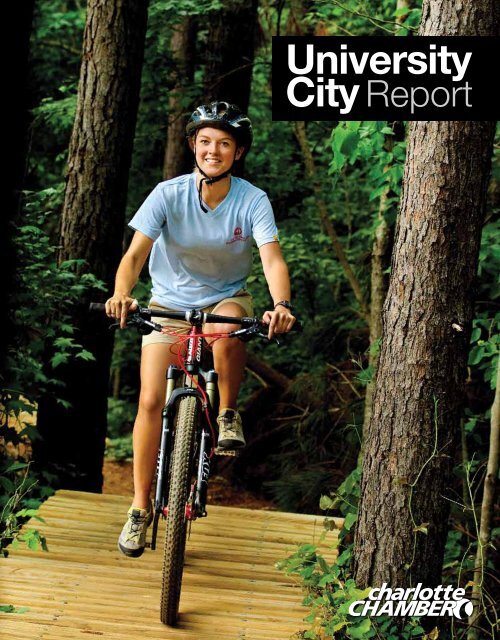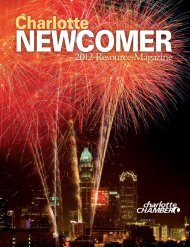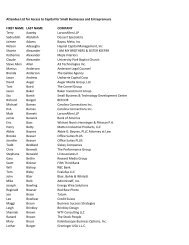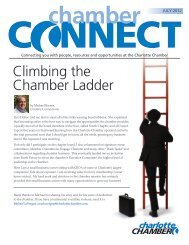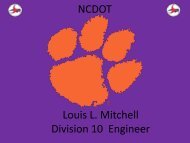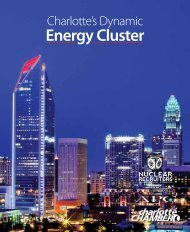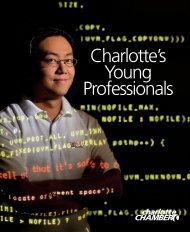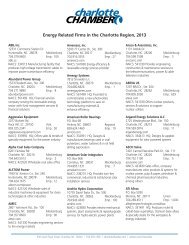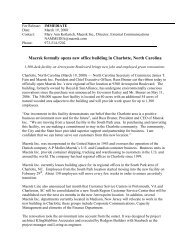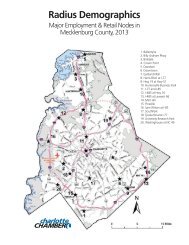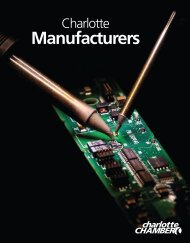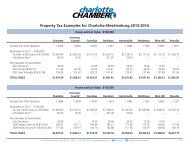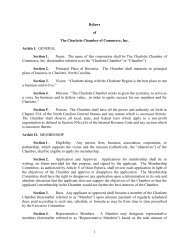University City Report (PDF) - Charlotte Chamber of Commerce
University City Report (PDF) - Charlotte Chamber of Commerce
University City Report (PDF) - Charlotte Chamber of Commerce
Create successful ePaper yourself
Turn your PDF publications into a flip-book with our unique Google optimized e-Paper software.
<strong>University</strong><br />
<strong>City</strong> <strong>Report</strong><br />
<strong>University</strong> <strong>City</strong> <strong>Report</strong> 1
Reaping the Benefits <strong>of</strong><br />
A Bold Vision<br />
It shouldn’t be hard to imagine the outskirts <strong>of</strong><br />
<strong>Charlotte</strong>, N.C., back in the 1960s. If you longed to<br />
escape the urban confines <strong>of</strong> the Queen <strong>City</strong>, a<br />
short drive would have placed you alongside the<br />
familiar fields and pastures <strong>of</strong> the quiet, North<br />
Carolina countryside. Northeast <strong>of</strong> the city<br />
you would have found a typical rural setting,<br />
another large expanse <strong>of</strong> thriving farmlands.<br />
along with them. With countless amenities the<br />
area has become a haven to these residents<br />
and also a comfortable locale for the thousands<br />
<strong>of</strong> commuters who are employed there with<br />
companies large and small.<br />
<strong>University</strong> <strong>City</strong> has evolved over the years.<br />
But if you’re ever heading northeast <strong>of</strong> <strong>Charlotte</strong>,<br />
still hoping to escape the hustle and bustle <strong>of</strong><br />
the big city, have no fear: you’ll still find plenty <strong>of</strong><br />
green space there, and that pastoral setting you’re<br />
looking for is probably right around the corner.<br />
Higher Learning is at the<br />
Heart <strong>of</strong> <strong>University</strong> <strong>City</strong><br />
Fast-forward 50 years, and today that same<br />
northeastern stretch <strong>of</strong> the Mecklenburg County<br />
map has been completely transformed. The area<br />
is still thriving, but in a new and exciting way. Half<br />
a century ago visionaries conceived a plan to<br />
transform those farmlands into <strong>University</strong> <strong>City</strong>, a<br />
town located on the fringe <strong>of</strong> <strong>Charlotte</strong> that has,<br />
over time, grown strong enough to stand on its<br />
own merits. Identified mostly in the past by UNC<br />
<strong>Charlotte</strong> and the <strong>University</strong> Research Park (URP),<br />
those building blocks served as a foundation<br />
for a surge in population that now transcends<br />
those two institutions. Today, if <strong>University</strong> <strong>City</strong><br />
were separated from <strong>Charlotte</strong>, it would be the<br />
seventh largest city in North Carolina. That’s a<br />
fairly substantial growth rate for only 50 years <strong>of</strong><br />
existence.<br />
Branching out from the intersection <strong>of</strong> W.T.<br />
Harris Boulevard and North Tryon — the nexus<br />
<strong>of</strong> <strong>University</strong> <strong>City</strong> — the local community has<br />
exploded to more than 170,000 residents, and<br />
a strong infrastructure has developed right<br />
Obviously, <strong>University</strong> <strong>City</strong> would not be<br />
<strong>University</strong> <strong>City</strong> without UNC <strong>Charlotte</strong>. In fact,<br />
it’s quite possible that the town would have<br />
an entirely different name had its centerpiece<br />
institution not matured over the past 60 years.<br />
Originally a small evening college center that<br />
opened in 1946, UNC <strong>Charlotte</strong> now boasts a<br />
student enrollment that exceeds 25,000 students.<br />
Early on, the college went through a series<br />
<strong>of</strong> transitions before becoming the blossoming<br />
educational institution it is today. When the state<br />
2<br />
<strong>University</strong> <strong>City</strong> <strong>Report</strong>
©PatrickSchneiderPhoto.com<br />
decided to shut down its college centers back in<br />
1949, the Queen <strong>City</strong>’s business and education<br />
leaders commandeered the center, and <strong>Charlotte</strong><br />
College was formed. By 1965 the college had<br />
joined the <strong>University</strong> <strong>of</strong> North Carolina system, and<br />
today UNC <strong>Charlotte</strong> is the fourth-largest school in<br />
that 16-campus system.<br />
With a full-time faculty that is 900 strong, and<br />
now <strong>of</strong>fering 19 doctorate, 80 graduate and 90<br />
bachelor programs, the institution is a valuable<br />
resource not only for <strong>University</strong> <strong>City</strong> but the greater<br />
<strong>Charlotte</strong> region as well. Obviously, the university<br />
has come a long way since its tiny college center<br />
days. But UNC <strong>Charlotte</strong>’s growth continues at a<br />
stunning — and extremely exciting — rate.<br />
Construction for the Energy Production and<br />
Infrastructure Center (EPIC) at UNC <strong>Charlotte</strong><br />
is currently underway. The $76-million facility<br />
will augment the <strong>Charlotte</strong> Research Institute<br />
campus and will conduct research in new energy<br />
technologies. This is also a boon for UNC <strong>Charlotte</strong><br />
students. By utilizing the EPIC building’s state-<strong>of</strong>the-art<br />
lab facilities students will receive hands-on<br />
experience with a laundry list <strong>of</strong> industry leaders,<br />
including Duke Energy Corp., Siemens Energy, Inc.,<br />
the Shaw Power Group and AREVA.<br />
Across from the EPIC facility, construction also<br />
continues on a brand-new UNC <strong>Charlotte</strong> football<br />
stadium. The 49ers will begin competing in 2013<br />
when football returns to their campus for the first<br />
time since 1948. Football will join the 16 other<br />
UNC <strong>Charlotte</strong> varsity sports teams that currently<br />
compete in the Atlantic 10 Conference.<br />
However, when it comes to education UNC<br />
<strong>Charlotte</strong> isn’t the only cutting edge campus in<br />
<strong>University</strong> <strong>City</strong>. Like the university before it, the<br />
Governor’s Village, a cluster <strong>of</strong> four <strong>Charlotte</strong>-<br />
Mecklenburg Schools (CMS), was yet another<br />
feat <strong>of</strong> planning and foresight. Named after four<br />
N.C. governors, the schools covered every grade<br />
for primary and secondary students living in<br />
<strong>University</strong> <strong>City</strong>. The four schools are Nathaniel<br />
Alexander Elementary School, James Martin<br />
Middle School, Vance High School and John<br />
Motley Morehead STEM Academy (a magnet<br />
school that was named a School <strong>of</strong> Distinction in<br />
2011).<br />
Initiated in the mid-1990s, the campus was an<br />
experiment designed to provide a unified K-12<br />
approach to learning, a workplace magnet for URP<br />
employees and a new technology-based system<br />
to increase communication between parents<br />
and schools. With its close proximity to URP, the<br />
campus sat at the forefront <strong>of</strong> innovation as it<br />
received millions <strong>of</strong> dollars in technology grants<br />
from IBM.<br />
Due to <strong>University</strong> <strong>City</strong>’s population explosion,<br />
in 2001 CMS removed the workplace magnet<br />
designation from the Governor’s Village schools to<br />
accommodate the increasing influx <strong>of</strong> students.<br />
Though IBM ended its grant around the same<br />
time, new partnerships have formed that will once<br />
again connect the public school campus to area<br />
businesses and also to the university.<br />
Financial services titan TIAA-CREF and UNC<br />
<strong>Charlotte</strong> recently announced a partnership to<br />
provide additional support to the 4,700 students<br />
and 500 faculty members in Governor’s Village.<br />
Job shadowing, tutoring and pr<strong>of</strong>essional<br />
development are just some <strong>of</strong> the services<br />
provided to the schools, enhancing the student<br />
experience while returning the Governor’s Village<br />
to its initial design <strong>of</strong> <strong>of</strong>fering unique opportunities<br />
in conjunction with local businesses and<br />
institutions.<br />
When it comes to education, UNC <strong>Charlotte</strong><br />
and the Governor’s Village might stand out, but<br />
they shouldn’t overshadow the myriad <strong>of</strong> other<br />
<strong>University</strong> <strong>City</strong> <strong>Report</strong> 3
Electric Power Research Institute (EPRI),<br />
arrived in <strong>University</strong> <strong>City</strong> in 1987.<br />
©PatrickSchneiderPhoto.com<br />
educational opportunities available in <strong>University</strong><br />
<strong>City</strong>, ranging from the slew <strong>of</strong> local private schools<br />
to Central Piedmont Community College’s Cato<br />
Campus. Just by its name alone, it’s obvious that<br />
education has a sturdy foundation in <strong>University</strong><br />
<strong>City</strong>.<br />
Past Visionaries Pave the<br />
Way for New Pioneers<br />
A discussion <strong>of</strong> <strong>University</strong> <strong>City</strong> would be<br />
incomplete without discussing W.T. Harris, one <strong>of</strong><br />
<strong>Charlotte</strong>’s most important civic leaders. When he<br />
became president <strong>of</strong> the <strong>Charlotte</strong> <strong>Chamber</strong> <strong>of</strong><br />
<strong>Commerce</strong> in 1966 no one could have foretold<br />
the impact he would have on the city and<br />
especially on <strong>University</strong> Research Park (URP). In<br />
the mid-1960s the land URP now sits on was only<br />
accessible by horseback, jeep or helicopter. Today,<br />
as it continues to expand wide and far across the<br />
boulevard named after the visionary Harris, URP<br />
has become home to a variety <strong>of</strong> companies that<br />
lead the way in cutting edge technologies.<br />
Like any development, URP started as a dream.<br />
Frustrated after continually losing high-tech<br />
research and development companies to Research<br />
Triangle Park (RTP) in the Raleigh-Durham area,<br />
Harris spearheaded an effort to bring a similar<br />
research park to <strong>Charlotte</strong> to strengthen the<br />
community and provide jobs for its citizens. He<br />
also wanted URP to complement UNC <strong>Charlotte</strong>,<br />
which at the time had recently joined the<br />
<strong>University</strong> <strong>of</strong> North Carolina system. Harris, along<br />
with a group <strong>of</strong> community leaders, first pushed<br />
to provide the rural area with the necessary<br />
infrastructure to house tenants. Next came the<br />
need to provide the proper governance, financing<br />
and covenants for the property, so recruiting could<br />
begin in earnest.<br />
The URP ultimately broke ground on January<br />
11, 1968. Collins & Aikman Corporation, which<br />
produced automotive fabrics, became the<br />
research park’s first tenant. Shortly thereafter<br />
Reeves Brothers, another textile manufacturer,<br />
joined them. But a couple <strong>of</strong> years later, when a<br />
tech giant came calling, URP’s first seeds <strong>of</strong> true<br />
development were planted.<br />
In 1970 IBM took an option on 450 acres<br />
<strong>of</strong> land, which initially served as a ringing<br />
©PatrickSchneiderPhoto.com<br />
4<br />
<strong>University</strong> <strong>City</strong> <strong>Report</strong>
endorsement for what was, at the time, a nascent<br />
endeavor. Unfortunately, IBM’s plans were slow<br />
to develop. When the company considered<br />
selling some <strong>of</strong> its acreage to the Billy Graham<br />
Foundation in 1972, URP organizers flew to New<br />
York to meet with IBM leaders in an attempt to<br />
gauge the company’s support and to provide<br />
a push to move forward with their plans. URP<br />
organizers’ persistence was rewarded: after<br />
making minor concessions to the covenant,<br />
IBM announced in 1978 that it would begin<br />
construction on a facility. By 1979 the company<br />
had arrived in URP, and the research park finally<br />
had its flagship tenant.<br />
Other companies followed. By 1987 URP had<br />
12 tenants that employed 8,000 people. Another<br />
significant tenant, Electric Power Research Institute<br />
(EPRI), arrived during that timeframe. This was a<br />
major coup for the research park, since EPRI chose<br />
URP over a location in RTP or Atlanta, Ga. Electronic<br />
Data Systems (EDS) and Verbatim also arrived<br />
during this build-up, and soon URP had become<br />
exactly what Harris and his fellow civic leaders had<br />
envisioned: a hotbed for technology pioneers with<br />
a community steadily growing around it.<br />
The middle years <strong>of</strong> URP’s existence saw a<br />
shift to back <strong>of</strong>fices and call centers. Though<br />
not necessarily rooted in technology, this<br />
development gave rise to large opportunities for<br />
the research park, as financial firms Wells Fargo<br />
and TIAA-CREF built self-contained facilities on<br />
URP’s acreage. Wells Fargo’s Customer Information<br />
Center (CIC) is <strong>of</strong>ten mentioned in the same breath<br />
with the Pentagon simply due to the size and<br />
scope <strong>of</strong> the building, along with the amenities<br />
<strong>of</strong>fered inside. TIAA-CREF’s facility sits on the other<br />
side <strong>of</strong> W.T. Harris Boulevard and also boasts an<br />
impressive site that seems more like a college<br />
campus than an <strong>of</strong>fice complex. The company<br />
maintains strong ties to UNC <strong>Charlotte</strong>, which<br />
would certainly please Mr. Harris himself.<br />
But as the new millennium has progressed,<br />
URP has seen a return to its technological<br />
beginnings. DigitalOptics Corporation is a microelectronics,<br />
imaging and optics company based<br />
in San Jose, Calif., that built a gigantic <strong>of</strong>fice<br />
facility on-site. SPEED purchased the old Verbatim<br />
building and transformed it into a high-tech<br />
broadcast center. In 2009, global appliance-maker<br />
Electrolux announced its plans to move its North<br />
American headquarters to URP, making it the<br />
largest corporate relocation to <strong>Charlotte</strong> since<br />
1984. And though IBM relocated to URP’s recently<br />
erected Enovia building, its former facility, now<br />
called Innovation Park, is currently undergoing a<br />
facelift. The multi-tenant and 12-building facility<br />
will soon have a renovated site built in the mold<br />
<strong>of</strong> the campus located at Google’s headquarters<br />
in Mountain View, Calif.<br />
With its proximity to uptown and <strong>Charlotte</strong><br />
Douglas International Airport, its redundant power<br />
infrastructure and its campus-style setting, URP has<br />
proved to be a success after 50 years <strong>of</strong> existence.<br />
More importantly, it is now poised to grow and<br />
attract new companies — and their employees —<br />
well into the future. This impact on <strong>University</strong> <strong>City</strong><br />
cannot be understated and is evidenced by the<br />
community that now surrounds and supports it.<br />
Companies From Across<br />
The Globe Call <strong>University</strong><br />
<strong>City</strong> Home<br />
<strong>Charlotte</strong> has certainly seen its share <strong>of</strong> growth<br />
over the last 20 years. With a population that has<br />
©PatrickSchneiderPhoto.com<br />
<strong>University</strong> <strong>City</strong> <strong>Report</strong> 5
©PatrickSchneiderPhoto.com<br />
almost doubled in that timeframe, the influx <strong>of</strong><br />
new residents has been staggering. <strong>University</strong> <strong>City</strong><br />
has also grown dramatically, as more and more<br />
people have flocked to the fringe city. Like these<br />
citizens, many companies from across the globe<br />
have made <strong>University</strong> <strong>City</strong> home.<br />
The Queen <strong>City</strong> is the country’s second-largest<br />
banking center behind New York <strong>City</strong>, and two <strong>of</strong><br />
the world’s financial giants have a large presence in<br />
the <strong>University</strong> area. On any given day Wells Fargo<br />
has roughly 14,000 employees coming and going<br />
in its Customer Information Center (CIC) if support<br />
staff, trainees and visitors are included in the count.<br />
The facility was built in 1995 and has grown to 2<br />
million square feet in size. The campus is home<br />
to the bulk <strong>of</strong> the bank’s information technology<br />
and customer support units, and while many call<br />
center employees call the CIC home, plenty <strong>of</strong><br />
senior executives work within its walls as well.<br />
Nearby, TIAA-CREF boasts an impressive<br />
workplace <strong>of</strong> its own. Headquartered in New York<br />
<strong>City</strong>, the financial services firm is one <strong>of</strong> the nation’s<br />
leading retirement providers. Its <strong>University</strong> <strong>City</strong><br />
campus opened in 2000 and today houses around<br />
2,500 employees. The operation is one <strong>of</strong> the firm’s<br />
largest, proving that <strong>University</strong> <strong>City</strong> has become a<br />
haven for large financial institution facilities.<br />
Other companies contribute to the financial<br />
industry as well. URP neighbor IBM, though<br />
known primarily for its technological prowess,<br />
now provides support for local mortgage<br />
industry clients. And financial firms aren’t<br />
the only ones with operations in the area;<br />
Convergys and AT&T Communications also have<br />
facilities close-by.<br />
Industry also has an international flavor in<br />
<strong>University</strong> <strong>City</strong>, as many foreign-owned firms<br />
have moved in. The largest is AREVA, which<br />
has more than 700 employees in <strong>University</strong><br />
<strong>City</strong>. Based in France and headquartered in<br />
Paris, the company prides itself on supplying<br />
low-carbon energy solutions to North America.<br />
Since AREVA is the largest engineering firm<br />
in town, most <strong>of</strong> the local staff is engaged in<br />
engineering for its nuclear energy business.<br />
Two Swedish firms have gone as far as to place<br />
their North American operations in <strong>University</strong><br />
<strong>City</strong>: Electrolux, an appliance maker, and The<br />
Husqvarna Group, which manufactures outdoor<br />
power products. These recent developments<br />
have stamped <strong>University</strong> <strong>City</strong> as a thriving<br />
market for employers from near and far, even<br />
as the global economy has suffered through a<br />
number <strong>of</strong> ups and downs over the last decade.<br />
Business is booming in <strong>University</strong> <strong>City</strong> as<br />
industry stalwarts have remained and new<br />
companies have arrived. In fact, for many years<br />
local commuters converged on the center city <strong>of</strong><br />
<strong>Charlotte</strong>, aiming toward the cluster <strong>of</strong> skyscrapers<br />
in the distance before beginning their workdays.<br />
Now many <strong>University</strong> <strong>City</strong> residents are sticking<br />
closer to home as their fringe city provides plenty<br />
<strong>of</strong> employment opportunities. Others are still<br />
making the commute, but now the skyline <strong>of</strong><br />
uptown is in their rearview mirrors instead.<br />
An Abundance <strong>of</strong> Alternatives<br />
for a Healthy Lifestyle<br />
When it comes to health and fitness, <strong>University</strong><br />
<strong>City</strong> stands strongly on its own two legs. With an<br />
award-winning hospital, numerous fitness options<br />
and plenty <strong>of</strong> green space, health-conscious<br />
citizens have countless ways to continue their<br />
active lifestyles.<br />
A community’s health needs start with the<br />
availability <strong>of</strong> world-class health care. Since<br />
Carolinas Medical Center-<strong>University</strong> serves as<br />
one <strong>of</strong> the anchors for <strong>University</strong> <strong>City</strong>’s “town<br />
square” (the intersection <strong>of</strong> W.T. Harris Boulevard<br />
and North Tryon Street), that need is definitely<br />
6<br />
<strong>University</strong> <strong>City</strong> <strong>Report</strong>
satisfied. The hospital, which opened as <strong>University</strong><br />
Memorial Hospital in the mid-1980s, is by far<br />
the largest in the university area, and also serves<br />
northern Mecklenburg County and southwestern<br />
Cabarrus County. Serving a wide group <strong>of</strong> patients<br />
is one thing, though; providing those patients<br />
with award-winning service is another. J.D. Power<br />
and Associates has named CMC-<strong>University</strong> a<br />
“Distinguished Hospital” and also recognized<br />
the hospital’s maternity center for “Outstanding<br />
Patient Experience” for three years running.<br />
Aside from its first-class service, CMC-<strong>University</strong><br />
also <strong>of</strong>fers a wide range <strong>of</strong> surgical specialties,<br />
ranging from orthopedics to urology. With<br />
more than 8,700 surgical procedures performed<br />
annually, patients receive not only expert care<br />
but also a wide breadth <strong>of</strong> care. Adjacent medical<br />
<strong>of</strong>fices only strengthen CMC-<strong>University</strong>, as does<br />
being affiliated with one <strong>of</strong> the strongest health<br />
care systems in the Southeast. But what makes<br />
the hospital even more impressive is the fact that<br />
it promotes health and wellness beyond its own<br />
doors. Partnering with the <strong>University</strong> <strong>City</strong> YMCA<br />
and organizing the LiveWell Carolinas! Program<br />
©PatrickSchneiderPhoto.com<br />
in Northlake Mall, CMC-<strong>University</strong> is involved in<br />
the community in an effort to keep residents<br />
educated and informed.<br />
Of course, many Americans exercise daily<br />
with the hope <strong>of</strong> avoiding a trip to the hospital<br />
altogether. Enter the <strong>University</strong> <strong>City</strong> YMCA, which<br />
<strong>of</strong>fers more than just a typical fitness center filled<br />
with cardio equipment. The facility also has an<br />
outdoor water park, an indoor pool, a sports fields<br />
and an indoor track. Personal health coaching<br />
is also available, be it fitness assessments, diet<br />
consultations or personal training sessions. Adults<br />
and children alike can choose from a wide variety<br />
<strong>of</strong> group exercise classes, such as yoga, dance or<br />
water aerobics, or play traditional team sports like<br />
basketball, soccer and flag-football.<br />
If you’re the type that strictly prefers the great<br />
outdoors, then there are plenty <strong>of</strong> options in<br />
<strong>University</strong> <strong>City</strong> that supply open space and fresh<br />
air. Together Clark’s Creek and Mallard Creek<br />
Greenways make up the longest stretch <strong>of</strong><br />
Mecklenburg County’s greenways, providing<br />
more than seven miles <strong>of</strong> trails. Those seven miles<br />
<strong>of</strong>fer various backdrops for athletic endeavors,<br />
such as university neighborhoods, <strong>University</strong><br />
Research Park (URP) and a mature floodplain<br />
forest. But that’s just one option for the outdoor<br />
enthusiast.<br />
The Toby Creek Greenway not only links<br />
up with the previous two greenways but also<br />
connects with the UNC <strong>Charlotte</strong> campus,<br />
which <strong>of</strong>fers fitness trails and bike paths <strong>of</strong> its<br />
own. Nearby Ribbon Walk Nature Preserves is a<br />
188-acre urban forest with three miles <strong>of</strong> hiking<br />
trails. Regional and community parks are located<br />
throughout <strong>University</strong> <strong>City</strong>’s neighborhoods. And<br />
<strong>University</strong> <strong>City</strong> <strong>Report</strong> 7
avid golfers can choose from The Tradition Golf<br />
Club or Highland Creek Golf Club to fine-tune<br />
their games.<br />
With a top-notch health care facility<br />
nearby and multiple options for every fitness<br />
undertaking, a <strong>University</strong> <strong>City</strong> resident has plenty<br />
<strong>of</strong> amenities to choose from when it comes to<br />
leading a healthy lifestyle.<br />
On the Fast Track<br />
To the Future<br />
One obvious signal <strong>of</strong> <strong>University</strong> <strong>City</strong>’s<br />
transformation from farmland to fringe town is the<br />
transportation infrastructure that has developed<br />
to support it. With two major thoroughfares in<br />
W.T. Harris Boulevard and North Tryon Street,<br />
along with the development <strong>of</strong> the I-485 beltway,<br />
<strong>University</strong> <strong>City</strong> is more accessible than it ever has<br />
been. But even more changes are coming, and<br />
they are changes that will position the suburban<br />
community perfectly for the future.<br />
Light rail arrived in <strong>Charlotte</strong> in 2007 and<br />
has been hailed as a great success; ridership has<br />
already exceeded long-term expectations. Now<br />
the light rail service is on its way to <strong>University</strong> <strong>City</strong><br />
as well. The <strong>Charlotte</strong> Area Transit System’s (CATS)<br />
LYNX blue line will connect the Queen <strong>City</strong>’s<br />
uptown to UNC <strong>Charlotte</strong>, stretching almost 10<br />
miles from center city to the campus.<br />
Local employers, along with their employees,<br />
will benefit greatly from the proposed expansion,<br />
which is slated for completion in 2017. Soon it will<br />
only take commuters a projected 22 minutes to<br />
get from the university to uptown <strong>Charlotte</strong>. Aside<br />
from the obvious business impact, <strong>University</strong> <strong>City</strong><br />
residents will also have a means <strong>of</strong> alternative<br />
transportation to attend center city’s multiple<br />
entertainment attractions, be it a concert at Time<br />
Warner Cable Arena, a Carolina Panthers game at<br />
Bank <strong>of</strong> America Stadium or a performance at the<br />
Blumenthal Performing Arts Center. And students<br />
will be able to travel easily between the main<br />
and uptown campuses, while citizens living in<br />
<strong>Charlotte</strong> proper who want to catch a 49ers game<br />
will have a new transit option as well.<br />
Eleven new stations are planned for the<br />
expansion, which will extend from center city to<br />
North Davidson, then follow North Tryon Street<br />
(US 29) as it cruises all the way into UNC <strong>Charlotte</strong>’s<br />
campus. With a cost no greater than the average<br />
bus fare and trains running every day (and every<br />
10 minutes during the weekday rush hour), transit<br />
will be cheaper and more convenient than it has<br />
ever been along the “Northeast Corridor.”<br />
However, the blue line extension isn’t the only<br />
major transportation change coming to <strong>University</strong><br />
<strong>City</strong>. The long-delayed completion <strong>of</strong> the I-485<br />
beltway is another huge piece <strong>of</strong> the area’s<br />
transportation puzzle. Budget cuts had delayed<br />
construction, leaving a gap in the beltway in<br />
northeast <strong>Charlotte</strong>. But construction to complete<br />
this 5.7-mile void is already underway and is<br />
scheduled for completion in 2014.<br />
Along with finishing I-485, the construction<br />
team will also tackle the widening <strong>of</strong> I-85 all the<br />
way out to Cabarrus County and create a number<br />
<strong>of</strong> new exchanges along the new section <strong>of</strong> the<br />
beltway to aid the flow <strong>of</strong> traffic and improve<br />
driver safety. The project will include cuttingedge<br />
designs that have not been utilized before<br />
in the state <strong>of</strong> North Carolina: a split diamond<br />
interchange at Prosperity Church Road, a diverging<br />
diamond interchange for Mallard Creek Road<br />
and the conversion <strong>of</strong> the I-85/I-485 trumpet<br />
interchange to a turbine exchange. Those three<br />
endeavors will make entering and exiting I-485 a<br />
breeze, keeping the flow <strong>of</strong> traffic steady on what<br />
will certainly be high-traffic ramps.<br />
Throw in the recent completion <strong>of</strong> the US 29/<br />
NC 49 connector — which eased traffic for the<br />
70,000 vehicles that pass through the quarter-mile<br />
stretch <strong>of</strong> North Tryon Street between the end <strong>of</strong><br />
<strong>University</strong> <strong>City</strong> Boulevard and the I-85 exchange<br />
— and an amazing transportation facelift has<br />
already occurred in a short period <strong>of</strong> time. In<br />
fact, the US 29/NC 49 connector project was<br />
completed nine months early and under budget.<br />
As stated previously, <strong>University</strong> <strong>City</strong> is exploding in<br />
population and in the number <strong>of</strong> commuters and<br />
visitors coming and going each year. Soon, all that<br />
coming and going will be a whole lot easier.<br />
Bright Lights, Little <strong>City</strong><br />
Whether you’re a resident living nearby or a<br />
visitor passing through, you definitely will not be<br />
bored in <strong>University</strong> <strong>City</strong>. The area has a multitude<br />
©PatrickSchneiderPhoto.com<br />
8<br />
<strong>University</strong> <strong>City</strong> <strong>Report</strong>
<strong>of</strong> shopping destinations, diverse restaurants and<br />
engaging attractions to occupy your time.<br />
One favorite spot amongst locals is the<br />
Shoppes at <strong>University</strong> Place. If the intersection <strong>of</strong><br />
W.T. Harris Boulevard and North Tryon Street is the<br />
<strong>University</strong> <strong>City</strong>’s “town square,” then the mixed-use<br />
shopping center is certainly one <strong>of</strong> the area’s most<br />
popular gathering places for friends and family.<br />
Aside from its assembly <strong>of</strong> stores and<br />
restaurants, the Shoppes at <strong>University</strong> Place <strong>of</strong>fer<br />
a family-friendly and open-air environment. With<br />
a lake rippling in the heart <strong>of</strong> the shopping center,<br />
pedestrians can take to “The Boardwalk” or the<br />
two-mile trail that surrounds the lake, while others<br />
can churn their legs in paddle boats out on the<br />
lake’s tranquil surface. Afterward a bite to eat at<br />
the popular Boardwalk Billy’s or a drink at local<br />
haunt The Wine Vault can cap <strong>of</strong>f a day perfectly.<br />
There are plenty <strong>of</strong> other shopping options<br />
nearby. North Carolina’s Concord Mills, a<br />
behemoth <strong>of</strong> a mall that is the state’s #1 tourist<br />
attraction, is just a short drive up I-85 and <strong>of</strong>fers<br />
a full host <strong>of</strong> shopping options, ranging from a<br />
Bass Pro Shops location to a Polo Ralph Lauren<br />
Factory Store. The world’s number one homefurnishings<br />
retailer, IKEA, has its own boulevard<br />
right <strong>of</strong>f North Tryon Street — and it’s the only<br />
IKEA between Washington, D.C., and Atlanta, Ga.<br />
And grocery-wise there are typical options like<br />
Harris Teeter, Food Lion and Trader Joe’s, as well as<br />
LEGEND<br />
MSD Boundary<br />
Edge Areas<br />
Proposed Station Location<br />
Existing Streets<br />
Proposed Streets<br />
Office<br />
Mixed Use with<br />
Ground Floor<br />
Retail<br />
Single<br />
Family Residential<br />
Edge Area<br />
A-1<br />
Institutional<br />
Open Space/Park<br />
ark<br />
an increasing number <strong>of</strong> specialty stores selling<br />
ethnic foods.<br />
When it comes to dining, ethnic fare is<br />
available in specialty stores and full-fledged<br />
restaurants. A myriad <strong>of</strong> cuisines are represented<br />
in <strong>University</strong> <strong>City</strong>, such as Thai by Thai Taste,<br />
Vietnamese by Pho Real, Moroccan by Casablanca<br />
Café or Italian by Amalfi’s Pasta ’n’ Pizza. And<br />
those are only a small handful <strong>of</strong> ethnic eating<br />
alternatives that are available.<br />
For a fine dining experience, Firewater <strong>of</strong>fers<br />
eclectic American cuisine in a modern, romantic<br />
setting. The menu is far-reaching, including<br />
steak and seafood, and is accompanied by a<br />
comprehensive wine list. But those craving good<br />
old-fashioned Southern BBQ can visit Farmer’s BBQ<br />
on Mallard Creek Church Road where they’ll find<br />
meats smoked in-house, while vegetarians are<br />
covered by Zizi’s Vegetarian Restaurant at Gold Hill<br />
Pavilion, where 100 percent vegan fare is <strong>of</strong>fered<br />
for take-out.<br />
As far as local attractions, <strong>University</strong> <strong>City</strong><br />
certainly comes alive during race season. Just up<br />
the road is <strong>Charlotte</strong> Motor Speedway, which plays<br />
to hosts to several NASCAR events throughout<br />
the year. The 1.5-mile super speedway is a blessing<br />
for local fans but attracts tourists from across the<br />
country not only to <strong>University</strong> <strong>City</strong> but also to<br />
<strong>Charlotte</strong>. Aside from having the opportunity to<br />
watch drivers in action, fans <strong>of</strong> Jeff Gordon, Jimmie<br />
Transit Oriented Residential<br />
I-85<br />
McCullough<br />
Harris Blvd.<br />
Proposed Harris<br />
/N. Tryon<br />
Station<br />
Proposed <strong>City</strong><br />
Boulevard<br />
Station<br />
Edge Area<br />
A-2<br />
JW Clay<br />
Proposed<br />
<strong>University</strong> <strong>City</strong><br />
Station<br />
Johnson and Dale Earnhardt, Jr. can also visit the<br />
nearby Hendrick Motorsports Museum and Team<br />
Store for free.<br />
Music-lovers are also covered by nearby Verizon<br />
Wireless Amphitheater. Operated by LiveNation,<br />
the outdoor amphitheater is considered one <strong>of</strong> the<br />
premiere concert venues in the Metrolina region.<br />
With reserved seating or lawn seating and a variety<br />
<strong>of</strong> acts including country, rock, alternative, pop<br />
and hip-hop, the amphitheater can provide a full<br />
evening <strong>of</strong> entertainment.<br />
For visitors seeking a place to stay, plenty<br />
<strong>of</strong> options are convenient to the attractions<br />
and businesses nearby. Boasting more than 17<br />
combined hotels and motels with more than<br />
2,100 guest rooms, finding accommodations in<br />
the <strong>University</strong> <strong>City</strong> area will definitely not be a<br />
problem. One standout is the Hilton <strong>Charlotte</strong><br />
<strong>University</strong> Place, which is directly beside the<br />
Shoppes at <strong>University</strong> Place. The Hilton has 393<br />
recently renovated deluxe guestrooms and suites,<br />
some <strong>of</strong> which overlook the nearby lake. This is but<br />
one option, as a slew <strong>of</strong> national chains provide<br />
comfortable places to lay your head too.<br />
Those living in neighboring developments<br />
know they want for nothing; <strong>University</strong> <strong>City</strong><br />
provides plenty <strong>of</strong> activities and entertainment to<br />
keep its residents busy. For visitors, the attractions<br />
and amenities hold their attention and quite <strong>of</strong>ten<br />
lead to an extended stay.<br />
Edge Area<br />
B<br />
N. Tryon<br />
E. Mallard Creek<br />
Church Road<br />
Proposed<br />
UNC-<strong>Charlotte</strong><br />
Station<br />
Proposed<br />
Mallard Creek<br />
Church Station<br />
Road<br />
John Kirk<br />
US 29/NC49<br />
Proposed<br />
Rocky River<br />
Station<br />
0’ 700’ 1400’<br />
Rocky River<br />
<strong>University</strong> <strong>City</strong> Boulevard<br />
Edge Area<br />
C<br />
Edge Area<br />
C<br />
<strong>University</strong> <strong>of</strong> North Carolina<br />
at <strong>Charlotte</strong><br />
Carolinas Medical<br />
Center<br />
Potential Development Scenario <strong>of</strong> the MSD Edge Areas<br />
<strong>University</strong> <strong>City</strong> <strong>Report</strong> 9
<strong>University</strong> <strong>City</strong> Area<br />
RIDGE<br />
BEARD<br />
PROSPERITY CHURCH<br />
STATESVILLE<br />
OLD STATESVILLE<br />
HUCKS<br />
DAVID COX<br />
85<br />
MALLARD CREEK<br />
GIBBON<br />
OLD STATESVILLE<br />
2 8 2 6 9<br />
TRYON<br />
2 8 2 6 2<br />
PAVILION<br />
485<br />
BACK CREEK CHURCH<br />
NEVIN<br />
UNIVERSITY CITY<br />
CINDY<br />
85<br />
GRAHAM<br />
SUGAR CREEK<br />
2 8 2 1 3<br />
OLD CONCORD<br />
ROCKY RIVER<br />
NORRIS<br />
2 8 2 0 6<br />
DALTON<br />
CALDWELL<br />
10<br />
<strong>University</strong> <strong>City</strong> <strong>Report</strong>
<strong>University</strong> Area Demographics<br />
<strong>University</strong> Zip Code Zip Code Zip Code Zip Code<br />
Area Total 28206 28213 28269 28262<br />
Population<br />
2000 Total Population 102,313 12,508 25,891 42,430 21,484<br />
2010 Total Population 168,357 13,624 38,770 75,334 40,629<br />
2015 Total Population 199,974 14,505 44,476 92,130 48,863<br />
2010-2015 Annual Rate 3.50% 1.26% 2.78% 4.11% 3.76%<br />
Households<br />
2000 Households 37,149 4,347 9,542 16,142 7,118<br />
2010 Households 63,659 4,876 14,579 29,458 14,746<br />
2015 Households 76,418 5,237 16,877 36,193 18,111<br />
Housing Units<br />
2010 Housing Units 69,679 4,867 15,975 31,858 16,179<br />
Owner Occupied Housing Units 54.4% 29.9% 52.9% 64.3% 47.4%<br />
Renter Occupied Housing Units 37.0% 62.4% 38.4% 28.1%<br />
Median Household Income<br />
2000 $48,733 $25,504 $41,432 $60,955 $53,130<br />
2010 $67,590 $29,563 $61,556 $77,153 $70,388<br />
Median Home Value<br />
2000 $132,190 $64,032 $103,465 $147,933 $136,404<br />
2010 $173,562 $80,169 $142,161 $187,786 $186,830<br />
2010 Household by Income<br />
Household Income Base $63,659 $4,876 $14,579 $29,458 $14,746<br />
Pr<strong>of</strong>iles <strong>of</strong><br />
<strong>University</strong> <strong>City</strong><br />
<strong>University</strong> <strong>City</strong> Partners<br />
<strong>University</strong> <strong>City</strong> has its own chapter within<br />
the <strong>Charlotte</strong> <strong>Chamber</strong> <strong>of</strong> <strong>Commerce</strong>, so the<br />
fact that it also has its own municipal service<br />
district only gives it an additional edge<br />
when it comes to leveraging local resources.<br />
While the <strong>Charlotte</strong> <strong>Chamber</strong> <strong>University</strong> <strong>City</strong><br />
Chapter provides businesses support by<br />
sponsoring events to build and strengthen<br />
relationships among its members, <strong>University</strong><br />
<strong>City</strong> Partners (UCP) is a focused entity that<br />
helps chart the commercial course for this<br />
suburban community.<br />
Mary Hopper<br />
<strong>University</strong> <strong>City</strong> Partners (UCP) is one<br />
<strong>of</strong> only three municipal service districts in <strong>Charlotte</strong>, with the other two<br />
located in Center <strong>City</strong> and South End. Founded in 2003, UCP was created to<br />
contribute additional resources to <strong>University</strong> <strong>City</strong>’s commercial core. Property<br />
tax revenues generated within the district are used, specifically, to enhance<br />
the area. With a steadily climbing population and its emergence as a growing<br />
business hub, <strong>University</strong> <strong>City</strong> fits the bill for this special status and, more<br />
importantly, benefits greatly from the additional support.<br />
COURTESY OF MARY HOPPER<br />
“We have an active board <strong>of</strong> directors that has put a lot <strong>of</strong> energy behind<br />
reshaping the area to be transit-supportive because they know that will<br />
further enhance what is already up here,” said Mary Hopper, UCP’s executive<br />
director. “It was the forward thinking <strong>of</strong> the property owners, led by the<br />
<strong>University</strong> <strong>City</strong> chapter <strong>of</strong> the <strong>Charlotte</strong> <strong>Chamber</strong>, who created <strong>University</strong> <strong>City</strong><br />
Partners eight years ago. The <strong>City</strong> Council felt good enough about what we<br />
had accomplished in our first five years that they unanimously approved our<br />
expanding to include the <strong>University</strong> Research Park.”<br />
<strong>University</strong> <strong>City</strong> already has so much going for it, so the fact that it has a<br />
dedicated advocate like UCP only enhances its appeal. Though certainly biased,<br />
Hopper is bullish about the future <strong>of</strong> the area in which she lives and works.<br />
“Opening this leg <strong>of</strong> I-485 and getting light rail will be the icing on the cake<br />
by increasing our accessibility,” she said. “People are understanding perhaps<br />
for the first time that UNC <strong>Charlotte</strong> is an enormous asset, so we are proud to<br />
share its name.”<br />
©PatrickSchneiderPhoto.com<br />
12<br />
<strong>University</strong> <strong>City</strong> <strong>Report</strong>
Electric Power Research Institute (EPRI),<br />
arrived in <strong>University</strong> <strong>City</strong> in 1987.<br />
©PatrickSchneiderPhoto.com<br />
Company Pr<strong>of</strong>ile: Electric Power Research Institute (EPRI)<br />
Located at 1300 W.T. Harris Boulevard, EPRI has been a <strong>University</strong> <strong>City</strong><br />
mainstay for many years. In the early 1980s the independent, nonpr<strong>of</strong>it<br />
organization established its Nondestructive Evaluation Center in URP, but<br />
over time EPRI has expanded its operations to include additional research<br />
and new testing laboratories and facilities.<br />
The organization assembles a team <strong>of</strong> its scientists and engineers as well<br />
as experts from academia and industry in an attempt to address challenges<br />
associated with electricity. When it comes to electricity, EPRI tackles a variety<br />
<strong>of</strong> issues, such as reliability, efficiency, health and safety.<br />
EPRI was initially drawn to <strong>Charlotte</strong> for its proximity to nuclear<br />
generation, which is the main subject <strong>of</strong> the center’s research. With UNC<br />
<strong>Charlotte</strong> also nearby, this made <strong>University</strong> <strong>City</strong>, along with its accessibility<br />
to the interstates and airport, an ideal location.<br />
“In recent years, with the emergence <strong>of</strong> <strong>Charlotte</strong> and the Carolinas as a<br />
center for the nuclear industry and the energy sector, we continue to see this<br />
location as one that brings great synergy among many <strong>of</strong> the energy and<br />
electricity companies in the world,” said Jeremy Dreier, the senior manager <strong>of</strong><br />
EPRI’s corporate communications.<br />
While Dreier noted the ease <strong>of</strong> access<br />
to the facility, he also pointed out that employees dine and shop in <strong>University</strong><br />
<strong>City</strong> and on some occasions make use <strong>of</strong> the greenway during lunchtime<br />
breaks. For a unique organization like EPRI, which needs <strong>of</strong>fice space as well as<br />
laboratory space, URP was a perfect location.<br />
“The area, including UNC <strong>Charlotte</strong>, <strong>of</strong>fers a good mix <strong>of</strong> companies and<br />
research organizations that are progressive, sophisticated, forward-thinking<br />
and generally very good for the <strong>Charlotte</strong> region,” he said.<br />
<strong>University</strong> <strong>City</strong> <strong>Report</strong><br />
13
Company Pr<strong>of</strong>ile: Electrolux<br />
Electrolux is one <strong>of</strong> URP’s newest members, having chosen the<br />
research park as the home for its North American operations in 2010. The<br />
216,000-square-foot facility is located at 10200 David Taylor Drive, and the<br />
company spent $13 million to renovate the building.<br />
Electrolux touts itself as the global leader in home appliances and<br />
appliances for pr<strong>of</strong>essional use. The company has many familiar household<br />
brands that reside under its banner, including Frigidaire and Eureka.<br />
The <strong>Charlotte</strong> headquarters is home to approximately 450 employees, a<br />
number the company expects to grow over the next five years. Electrolux’s<br />
relocation should not be downplayed — it’s the largest corporate<br />
relocation to <strong>Charlotte</strong> since insurer Royal & SunAlliance pulled up its<br />
stakes in 1984.<br />
The decision to place the headquarters in <strong>Charlotte</strong> was based<br />
on a number <strong>of</strong> factors: the skilled labor pool, access to a variety <strong>of</strong><br />
transportation options, local educational capabilities, incentives that <strong>of</strong>fset<br />
relocation costs, local government and business support, and numerous<br />
other quality-<strong>of</strong>-life elements. With these priorities in mind, <strong>University</strong> <strong>City</strong><br />
was an obvious choice. But location continues to plays a huge part in<br />
attracting businesses to the area.<br />
“Availability <strong>of</strong> transportation — road, rail and the nearby international<br />
airport — allows easy access for traveling to other business units globally<br />
and was an important factor in the decision to consolidate Electrolux<br />
North America operations in <strong>University</strong> <strong>City</strong>,” said Caryn Klebba, the director<br />
<strong>of</strong> the company’s corporate communications.<br />
Klebba cited <strong>Charlotte</strong>’s consistent ranking as a great place to live<br />
and work. She also pointed to the outstanding educational and housing<br />
resources, along with the strong local talent pool. But again, sometimes it’s<br />
about location, location, location.<br />
“We’re only a short drive from the many <strong>of</strong>ferings the wider region<br />
boasts <strong>of</strong>,” Klebba said.<br />
Caryn Klebba, director <strong>of</strong> Electrolux<br />
corporate communications.<br />
©PatrickSchneiderPhoto.com<br />
14 <strong>University</strong> <strong>City</strong> <strong>Report</strong>
John Marchionda, Husqvara’s<br />
Vice President <strong>of</strong> Marketing<br />
©PatrickSchneiderPhoto.com<br />
Company Pr<strong>of</strong>ile: The Husqvarna Group<br />
The Husqvarna Group has an interesting history as it was initially founded,<br />
in 1689, with a focus on making muskets. While the company also has a long<br />
history in the <strong>Charlotte</strong> market, 2009 marked a new era as <strong>University</strong> <strong>City</strong><br />
became home to Husqvarna’s “Headquarters for the Americas.” The company<br />
also has another local historical connection: Husqvarna was spun <strong>of</strong>f from<br />
<strong>University</strong> <strong>City</strong> neighbor Electrolux in 2006.<br />
The company has come a long way since its musket-making days.<br />
Husqvarna is now the world’s largest producer <strong>of</strong> outdoor power products.<br />
Many Americans are familiar with their <strong>of</strong>ferings, which range from chainsaws<br />
to lawn mowers to garden tractors. Poulan and Weed Eater are just two <strong>of</strong> the<br />
brands that fall under the Husqvarna name.<br />
Before the 2009 headquarters relocation announcement, the company<br />
already employed roughly 160 people at its Pr<strong>of</strong>essional Products<br />
headquarters stationed at 7349 Statesville Road. But when the time came to<br />
move from their main location in Augusta, Ga., other suitors came calling —<br />
some at the eleventh hour. But the N.C. Economic Investment Committee<br />
bestowed the company the state’s Job Development Investment Grant right<br />
before the headquarters announcement. Since the grant money is tied to<br />
performance targets, Husqvarna has to deliver on its promise <strong>of</strong> creating new<br />
jobs over the next nine years, which is a boon for employment in the area.<br />
In 2010 the company announced its plans to relocate its American<br />
headquarters to Harris Corners Corporate Park, which is located right <strong>of</strong>f<br />
I-77’s Exit 18. According to a company spokesperson, <strong>University</strong> <strong>City</strong> — and<br />
<strong>Charlotte</strong> in general — provides the perfect setting for many companies who<br />
are based overseas.<br />
“<strong>Charlotte</strong> is comfortable with its role as a major hub for multinational<br />
firms,” said John Marchionda, the vice president <strong>of</strong> marketing at Husqvarna.<br />
Marchionda noted <strong>University</strong> <strong>City</strong>’s central location as a huge selling<br />
point for businesses relocating or expanding to the region. Infrastructure is<br />
also a crucial determining factor. The area has a competitive edge due to site<br />
availability and operating resources that don’t exist elsewhere. Marchionda<br />
also pointed to <strong>University</strong> <strong>City</strong>’s cultural and social strengths, which benefit<br />
the company’s employees.<br />
“The area provides great amenities and services that increase one’s quality<br />
<strong>of</strong> life,” he said.<br />
<strong>University</strong> <strong>City</strong> <strong>Report</strong><br />
15
Personal Pr<strong>of</strong>ile:<br />
Tim Wallace<br />
Every town needs its own watering hole, a<br />
place for locals to gather and share a drink (or<br />
two) as they unwind after a long day <strong>of</strong> work. For<br />
<strong>University</strong> <strong>City</strong>, The Wine Vault is just such a place.<br />
Tucked away in The Shoppes at <strong>University</strong> Place,<br />
this haunt has been a favorite <strong>of</strong> locals for the<br />
past 25 years. While old-timers may remember<br />
the location as Slug’s Wine and Cheese, the store<br />
became The Wine Vault 18 years ago. With an<br />
excellent selection <strong>of</strong> wine and beer, and a patio<br />
overlooking the neighboring lake, it’s easy to kill<br />
an hour (or two) as you relax with your beverage<br />
<strong>of</strong> choice.<br />
Tim Wallace, who purchased The Wine Vault<br />
along with his three business partners 10 years<br />
ago, has also lived in the university area since 2003.<br />
Currently he resides close to his business — in<br />
fact, his home is right behind the shopping center<br />
in the Welwyn neighborhood. For Wallace, this<br />
set-up, along with <strong>University</strong> <strong>City</strong> itself, couldn’t be<br />
more convenient.<br />
“Everything’s here,” he said. “I don’t have to go<br />
anywhere. And I love that.”<br />
Wallace has a long history with The Wine<br />
Vault and with the area. Born in nearby Gastonia,<br />
Wallace graduated from UNC <strong>Charlotte</strong> in 1998<br />
and worked at The Wine Vault during his college<br />
days. After graduation Wallace moved away, but<br />
ultimately he returned to <strong>University</strong> <strong>City</strong> because it<br />
was where he was most comfortable.<br />
“We’ve looked at other parts <strong>of</strong> the city to live<br />
in and to open other stores in, but the people<br />
out here are much more relaxed, laid-back,<br />
comfortable,” he said.<br />
Not surprisingly, when asked to name a few <strong>of</strong><br />
his favorite local restaurants, many <strong>of</strong> his <strong>University</strong><br />
Place neighbors were mentioned: Boardwalk Billy’s,<br />
Ciro’s and Zapata’s. But for Wallace, the strength <strong>of</strong><br />
the area lies in its people.<br />
“I have a lot <strong>of</strong> customers who are retired. I have<br />
a lot <strong>of</strong> customers who are college kids,” he said.<br />
“And I have a huge amount <strong>of</strong> people who are in<br />
business at <strong>University</strong> Research Park that live out<br />
here. You know, I like that. It’s extremely diverse.”<br />
But Wallace took the time to point out that<br />
<strong>University</strong> <strong>City</strong> has a special kind <strong>of</strong> diversity.<br />
“Everybody thinks diversity is just a color<br />
thing,” he said. “But it’s also an age thing. It’s also<br />
an experience thing, an education thing. Out<br />
here you’ve got it all. There are still farmers that<br />
live out here.”<br />
16<br />
<strong>University</strong> <strong>City</strong> <strong>Report</strong><br />
©PatrickSchneiderPhoto.com
©PatrickSchneiderPhoto.com<br />
Personal Pr<strong>of</strong>ile: Sonja Gantt<br />
Most <strong>Charlotte</strong>ans know who Sonja Gantt is. As an anchor for local NBC<br />
affiliate WCNC-TV’s evening newscasts, she is welcomed into many local<br />
living rooms throughout the week. She’s worked for the station in that<br />
capacity since 1997.<br />
A local joke is that no one lives in <strong>Charlotte</strong> was actually born in <strong>Charlotte</strong>.<br />
In Gantt’s case this couldn’t be further from the truth. A <strong>Charlotte</strong> native, she<br />
grew up on the city’s North Side in the Hidden Valley neighborhood. She later<br />
attended East Mecklenburg High School before heading to UNC Chapel Hill.<br />
Gantt has also lived in <strong>University</strong> <strong>City</strong> — twice. She lived there for five<br />
years before moving to Chicago. But she moved back four years later, and has<br />
remained there for the last 14 years.<br />
“I like the feel <strong>of</strong> the area, and I think there’s a certain wonderful spirit<br />
over here,” she said. “And there’s a good mix <strong>of</strong> young and old. You know, I’m<br />
usually up at the <strong>University</strong> Y in the morning, and I love the fact that there are<br />
retirees up there. Sometimes there will be people like me who work a different<br />
schedule. It’s just a great mix.”<br />
In talking with Gantt, it’s very obvious that she loves the <strong>University</strong> YMCA,<br />
citing her affinity for working out and the classes the facility <strong>of</strong>fers. Of course,<br />
all that working out certainly works up an appetite. Though she doesn’t get<br />
to visit as <strong>of</strong>ten as she likes due to her schedule, she pointed to Nona’s Sweets<br />
Bakery Café, a family-owned and operated bakery in the university area, as one<br />
<strong>of</strong> her favorite places.<br />
But she didn’t limit her smaller local finds to food. One <strong>of</strong> her latest<br />
discoveries, The Last Word, is a used bookstore located in the Grand<br />
Promenade Village.<br />
“It’s such a cute little place,” she said. “I mean, I’ve found bestsellers up<br />
there for five bucks, six bucks. So it’s such a great resource for people who<br />
love reading, or my son who found video games in there. I think that’s a little<br />
hidden treasure.”<br />
Married with two children, Gantt believes anyone with a family looking<br />
to move or relocate to the <strong>Charlotte</strong> area would not be disappointed with<br />
<strong>University</strong> <strong>City</strong>.<br />
“When you move someplace and you have children, you’re always looking<br />
for things for them to do, and it’s definitely alive with plenty <strong>of</strong> children here.<br />
If you go up toward Mallard Creek Park on a Saturday — my son was playing<br />
soccer up there — I mean, there are just kids everywhere. And so I do think it’s<br />
a very welcoming place for families.”<br />
<strong>University</strong> <strong>City</strong> <strong>Report</strong><br />
17
Personal Pr<strong>of</strong>ile: Paul Petr<br />
A first-generation American, Paul Petr has a unique<br />
backstory that brought him to <strong>University</strong> <strong>City</strong>. The youngest<br />
<strong>of</strong> eight children, Petr’s parents immigrated from the Czech<br />
Republic to the United States after World War II as displaced<br />
refugees. Though a much smaller move, two years ago Petr<br />
and his family relocated to <strong>University</strong> <strong>City</strong> so he could be closer<br />
to the YMCA, where he serves as the executive director.<br />
Petr grew up in Michigan’s Upper Peninsula. He graduated<br />
from Northern Michigan <strong>University</strong> with a degree in recreation<br />
administration and then put that degree to use for many years:<br />
he has worked for the YMCA in a variety <strong>of</strong> capacities for two<br />
decades. After stints in Michigan, Kentucky and Wisconsin,<br />
the <strong>University</strong> <strong>City</strong> YMCA was lucky to find someone with his<br />
enthusiasm and experience.<br />
Petr started at the bottom and worked his way up through<br />
the YMCA ranks, enjoying the camaraderie he developed with<br />
volunteers and staff. Early on he worked in various entry-level<br />
positions, slowly climbing toward the leadership role he has<br />
today. He credits his success in part to his upbringing.<br />
“My parents taught me some great life lessons about hard<br />
work, giving your best, compassion for others and sticking to<br />
your goals,” he said.<br />
Petr, his wife and three daughters live in Highland Creek.<br />
All three <strong>of</strong> his daughters attend nearby Highland Creek<br />
Elementary School. The husband and father listed Rita’s Italian<br />
Ice and Ciro’s Italian Restaurant as local favorites, but it’s easy to<br />
tell that this is one active family.<br />
“When we have time on our hands we like to visit Reedy<br />
Creek Park, catch a <strong>Charlotte</strong> 49ers athletic event and<br />
participate in all the <strong>of</strong>ferings <strong>of</strong> the <strong>University</strong> <strong>City</strong> YMCA,”<br />
Petr said.<br />
When you live in close proximity to your workplace, it<br />
doesn’t get much more convenient than that. But for Petr,<br />
<strong>University</strong> <strong>City</strong> itself provides conveniences all on its own.<br />
Like most residents, Petr enjoys having whatever he needs at<br />
his disposal.<br />
“The <strong>University</strong> <strong>City</strong> area is close to all the major<br />
amenities but still provides a great quality <strong>of</strong> life for a young<br />
family,” he said.<br />
But no matter whom you ask, the strength <strong>of</strong> <strong>University</strong><br />
<strong>City</strong> seems to be in the people who live and work there. Petr<br />
isn’t the first person to say that, and he probably won’t be<br />
the last.<br />
“The people always make the difference,” he said. “There<br />
is an extremely diverse talent pool <strong>of</strong> people who want to<br />
get to know you and truly care how you are doing. Besides<br />
the larger international companies, we have some extremely<br />
strong smaller businesses all <strong>of</strong> which are on the cutting edge<br />
<strong>of</strong> their industries.”<br />
Coming from Petr, that’s really saying something. Don’t<br />
forget: this is a man who has lived in plenty <strong>of</strong> other places.<br />
©PatrickSchneiderPhoto.com<br />
18<br />
<strong>University</strong> <strong>City</strong> <strong>Report</strong>
Personal Pr<strong>of</strong>ile: George Battle<br />
George Battle, III is another <strong>Charlotte</strong>an who hasn’t strayed very far<br />
from home. He has lived in <strong>University</strong> <strong>City</strong> <strong>of</strong>f and on for 26 years. More<br />
importantly, he has worked behind the scenes at two <strong>of</strong> the most important<br />
institutions in town.<br />
Battle moved to <strong>University</strong> <strong>City</strong> in 1985 when he was only 12 years old<br />
and later attended West <strong>Charlotte</strong> High School. The “<strong>of</strong>f and on” aspect <strong>of</strong> his<br />
<strong>University</strong> <strong>City</strong> tenure was only due to higher learning, as he attended UNC-<br />
Chapel Hill and UNC School <strong>of</strong> Law. Currently he works as general counsel for<br />
<strong>Charlotte</strong>-Mecklenburg Schools (CMS), a position he has held for 15 months.<br />
In that role one <strong>of</strong> his main duties is serving as the chief legal counsel for<br />
the board <strong>of</strong> education. Prior to that, Battle was an in-house attorney with<br />
Carolinas HealthCare System for 11 years. Needless to say, he carries a huge<br />
burden <strong>of</strong> responsibility, and has for some time.<br />
Battle currently lives with his wife and daughter in the Fox Glen<br />
neighborhood near Highland Creek. After his impressive scholastic career,<br />
Battle returned to his old stomping grounds. A huge reason for that decision<br />
was the opportunity to be involved in the development <strong>of</strong> an area that has<br />
experienced — and continues to experience — a steady growth rate.<br />
“There’s some established areas <strong>of</strong> town where you go and, you know,<br />
you’re the latest wave <strong>of</strong> people just to be there,” Battle said. “With <strong>University</strong><br />
<strong>City</strong>, even moving out there in ’85 — and I know this sounds kind <strong>of</strong> strange<br />
— but you still have the sense that it’s growing. And you still have the sense<br />
that you’re part <strong>of</strong> building a community as opposed to following someone<br />
who’s already built a community, or just moving in there. You feel like you<br />
have a part in shaping it.”<br />
Aside from this pioneering spirit, Battle also likes that he has the best <strong>of</strong><br />
all worlds. He touched on the area’s diversity, and he loves the conveniences<br />
that come with living in a fringe city.<br />
“The real strong point for me is that you have all the benefits <strong>of</strong> the city,”<br />
he said. “You know, proximity to downtown, proximity to different types <strong>of</strong><br />
amenities with the feeling <strong>of</strong> actually being outside <strong>of</strong> the city, being in the<br />
suburbs. And that’s a difficult combination to muster, I think.”<br />
When it comes to naming some <strong>of</strong> his favorite local places, Battle quickly<br />
pointed to Golden Taipei, a Chinese restaurant in the Davis Lake community,<br />
as a family favorite. He claimed that he and his family typically eat there once<br />
a week, and it’s the place they take guests who come into town for a visit. He<br />
also noted that his wife and daughter, <strong>of</strong> course, love nearby Northlake Mall.<br />
As <strong>Charlotte</strong> and its fringe cities continue to grow, people who are<br />
moving or looking to relocate have many more choices than they did when<br />
Battle moved to the area as a child in 1985. But to Battle, anyone who is faced<br />
with that decision has an easy choice. And that pioneering spirit <strong>of</strong> his shone<br />
through once again.<br />
“The same spirit that would drive you to move or to seek out a new place<br />
is the type <strong>of</strong> attraction, I guess, that <strong>University</strong> <strong>City</strong> would have for you,” he<br />
said. “Just that sense <strong>of</strong> adventure and starting a new life, so to speak, and<br />
building something that’s all your own.”<br />
©PatrickSchneiderPhoto.com<br />
330 S. Tryon St., <strong>Charlotte</strong>, NC 28202<br />
(704) 378-1300<br />
twitter.com/cltecondev<br />
<strong>Charlotte</strong><strong>Chamber</strong>.com<br />
Photography by PatrickSchneiderPhoto.com<br />
Written by Patrick Saleeby<br />
Design by Andrea Ware<br />
1/12 1M<br />
Copyright 2012 by <strong>Charlotte</strong> <strong>Chamber</strong> <strong>of</strong> <strong>Commerce</strong>. All rights reserved. No part <strong>of</strong> the publication may be reproduced or transmitted in any<br />
form or by any means, electronic or mechanical, including photocopying, recording or by any information storage or retrieval system, without<br />
permission in writing from the <strong>Charlotte</strong> <strong>Chamber</strong>. The information in this publication is carefully gathered and compiled in such a way as to ensure<br />
maximum accuracy. The <strong>Charlotte</strong> <strong>Chamber</strong> cannot, and does not, guarantee either the correctness <strong>of</strong> all information furnished them nor the<br />
complete absence <strong>of</strong> errors and omissions. Hence, responsibility for same neither can be, nor is, assumed.<br />
<strong>University</strong> <strong>City</strong> <strong>Report</strong><br />
19
<strong>Charlotte</strong> is one <strong>of</strong> the fastest-growing cities in the nation.<br />
With our great location, world-acclaimed international hub airport,<br />
pr<strong>of</strong>essional sports, low energy costs, diverse and talented labor,<br />
and a nationally ranked education system, it’s easy to see why<br />
more businesses are flocking here every year.<br />
Visit BOOMcharlotte.com<br />
©PATRICKSCHNEIDERPHOTO.COM


